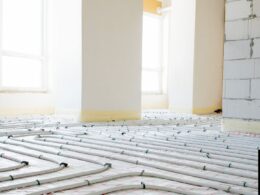Decking materials have evolved significantly over the years, transitioning from traditional wood to more contemporary options that offer a blend of benefits. Among the newer solutions is composite decking, an innovative choice that has gained popularity among homeowners. This article dives deep into the advantages and disadvantages of composite decking, giving a comprehensive perspective for those considering it for their outdoor spaces.

Advantages of Composite Decking
- Durability and Longevity
Unlike traditional wood, composite decking is renowned for its lasting power. Made primarily from a blend of recycled wood fibers and plastic, it is resistant to common issues that often plague wood decks, such as rotting, warping, and insect infestation. This enhanced durability ensures that composite decks maintain their aesthetic appeal and structural integrity over the years with minimal wear and tear. - Low Maintenance
For homeowners who dread the routine sanding, staining, or sealing associated with wooden decks, composite decking proves a boon. It requires minimal maintenance, with no need for annual refinishing. A simple wash now and then is sufficient to keep it looking fresh and new. - Aesthetic Appeal
With advanced manufacturing techniques, composite decking can mimic the natural textures and colors of various wood species. This gives homeowners a broad spectrum of aesthetic options without compromising on the benefits of composite materials. Furthermore, it doesn’t suffer from discoloration or fading as quickly as natural wood, ensuring that its beauty remains consistent over time. - Environmentally Friendly
Composite decking can be an environmentally-conscious choice for many homeowners. Since it often uses recycled wood fibers and plastics, it reduces the amount of waste that goes to landfills. Moreover, the longevity of composite decks means fewer replacements over time, leading to reduced consumption of materials. - Safety and Comfort
A notable benefit of composite decking is its slip-resistant surface, providing better traction even when wet. This characteristic can be especially vital in areas prone to rain or around pool decks. Additionally, since it doesn’t splinter like traditional wood, it offers a more comfortable and safer surface for barefoot enjoyment. - Resistant to Elements
Composite decks are designed to withstand various environmental conditions. They are resistant to fading from the sun, making them retain their color for a longer time compared to wood. Furthermore, they are less prone to damage from rain, snow, or temperature fluctuations, ensuring stability and longevity.

Disadvantages of Composite Decking
- Initial Cost
While composite decking can be cost-effective in the long run, its initial price can be considerably higher than traditional wooden decks. Homeowners might find the upfront investment daunting, though it’s essential to weigh this against the long-term benefits and potential savings on maintenance. - Limited Authenticity
For those who appreciate the natural beauty of real wood, composite decking, despite its advancements, might not fully capture the authentic look and feel of certain wood grains. It comes close, but the synthetic nature might be discernible to the discerning eye. - Potential for Heat Retention
In areas with high sunlight exposure, particularly during peak summer months, some composite decking materials can retain heat. This can make the deck uncomfortably warm to walk on in bare feet, reducing its usability during hot periods. - Less Structural Strength
Compared to traditional wood, composite materials might not offer the same level of structural strength. While they’re certainly strong enough for decking purposes, homeowners might need to consider reinforcement if planning heavier installations like hot tubs or outdoor kitchens on their decks.

How to take care about composite decking boards?
- Minimal Maintenance Required
One of the primary advantages of composite decking is its low maintenance. Unlike wood, which needs regular staining, sealing, or painting to maintain its appearance and integrity, composite decks just require occasional cleaning. Mild soap and water are usually enough to handle most spills and dirt. - Resistant to Most Stains
Composite decks are designed to resist many common stains, especially those that plague outdoor spaces like wine, mustard, or barbecue sauce. However, it’s still a good idea to address any spills as soon as possible to maintain the deck’s pristine look. - Avoiding Harsh Chemicals
While composite decking is robust and durable, homeowners should avoid using harsh chemicals when cleaning. These can break down the composite material over time. Always refer to the manufacturer’s cleaning recommendations to ensure the deck’s longevity. - Power Washing: Proceed with Caution
Power washing can be an effective way to clean a composite deck, but it’s essential to be careful. Too much pressure or directing the water stream at a shallow angle can damage the deck surface. It’s recommended to use a fan tip and keep the pressure under 1500 psi. - Addressing Minor Damages
Should your composite deck suffer scratches or minor damages, many can be fixed with a light sanding or by following the manufacturer’s repair recommendations. Always refer to the warranty or care guide provided at the time of installation for best practices.

Read more:








